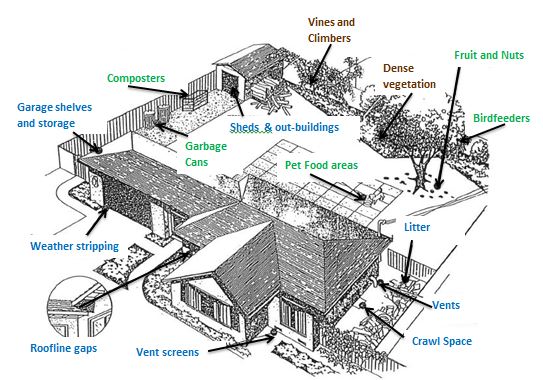Rodent management
Various rodents are found in the Okanagan. The house mouse has a small, slender body with pointed ears and a long tail. The field vole, common near weeds, is small and stocky with rounded ears and a short tail. The Deer mouse, which lives in forested areas, is recognized by its white underbelly. The rat most commonly found in the Okanagan is the black rat (also known as roof rat).
If you have spotted a rat in:
- A home or business
- Report the rat to the manager or property owner. Property owners are responsible for managing rats and rodents found on their property. Traps can be purchased at your local hardware store. If your home has an infestation that can’t be controlled through traps, contact a pest management company.
- A park or public spaces
- Rodents and rats spotted in parks and public spaces can be reported to Park Services at 250-71-PARKS (250-717-2757) or online by making a service request.

Ensure that your home and yard is rodent proof by removing access to food, water and shelter. Follow these tips:
Composters: Keep yard waste composters working efficiently, moist and regularly churned, use leaves and avoid grass clippings. Place 1/2” metal wire mesh under all compost and storage bins to block rodents.
Vines and climbers: Rats and rodents can use untrimmed, overgrown vines as runways
Fruit and nuts: Keep fruit and nut trees tidy and remove all dropped or rotten fruit
Bird feeders: A major animal attractant. Dropped and spilled seed is inevitable. Tidy areas around feeders and consider a tray under the feeder to catch dropped seed.
Pets: Don’t leave pet food accessible or outside overnight. Remove any uneaten or dropped feed. In some cases, rats can be attracted to pet waste; be sure to properly dispose of all waste in a proper receptacle.
Structures: Check all vents and screens along foundations and replace or repair any damage. Cover openings with 1/2” wire mesh. Check weather stripping and soffits for chew marks. Regularly check shelves and corners of sheds and outbuildings for rat droppings or signs of rodents. Remove “safe” places for rats and rodents by removing tall weeds, piles of unused lumber, litter and loose firewood.
Rat droppings: Rats leave 30 to 180 droppings per day, ranging from one half to three quarters of an inch in length and cylindrical in shape.
Runways: Rats tend to use the same path when they’re exploring their territory, and will therefore leave a well-worn path along beams, walls or vegetation. Check along walls, fences, pipes and beams for rub marks and worn paths.
Burrows: Rats will burrow beneath objects. Check for well-rounded holes five to eight centimetres (two to three inches) in diameter with worn paths.
Gnaw marks: The front teeth of rats are continually growing, so rats constantly gnaw to reduce the size of their teeth. Consequently, they can cause damage to structures or wiring.
More information on managing rodents and rats can be found by visiting Health Link BC.
We do not recommend using poisons or baits. Poisons can accidentally harm pets and wildlife.



